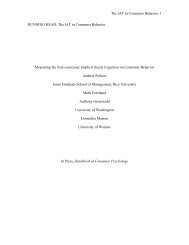The Beauty of Boundaries: When and Why We Seek Structure in ...
The Beauty of Boundaries: When and Why We Seek Structure in ...
The Beauty of Boundaries: When and Why We Seek Structure in ...
- No tags were found...
You also want an ePaper? Increase the reach of your titles
YUMPU automatically turns print PDFs into web optimized ePapers that Google loves.
18An additional way to demonstrate that the need for structure is an important underly<strong>in</strong>gfactor <strong>in</strong> consumers‘ desire for boundaries is to demonstrate that <strong>in</strong>dividuals‘ chronic needs forstructure are related to their desire for boundaries. A ‗chronic‘ need for structure refers to theextent to which people regularly desire simple structure <strong>in</strong> their lives (Neuberg <strong>and</strong> Newsom1993). <strong>The</strong> scale designed to capture the essence <strong>of</strong> this construct <strong>in</strong>cludes questions such as ―Ienjoy hav<strong>in</strong>g a clear <strong>and</strong> structured mode <strong>of</strong> life,‖ ―I like to have a place for everyth<strong>in</strong>g <strong>and</strong>everyth<strong>in</strong>g <strong>in</strong> its place.‖ If my hypothesis is correct <strong>and</strong> low feel<strong>in</strong>gs <strong>of</strong> control lead to a greaterpreference for boundaries because <strong>of</strong> an enhanced need for structure, then we should f<strong>in</strong>d that<strong>in</strong>dividuals with high chronic needs for structure have a greater preference for boundaries atbasel<strong>in</strong>e (i.e., when control is not threatened) than <strong>in</strong>dividuals without such needs for structure.To test this hypothesis, 28 adults were recruited onl<strong>in</strong>e <strong>and</strong> asked to complete the need forstructure scale (α = .80). <strong>The</strong>y then <strong>in</strong>dicated their preferences for a new measure <strong>of</strong> boundaries.Participants chose between items that can be characterized as explicitly bounded or not (e.g., apicture with a frame vs. no frame, a house surrounded by a fence vs. no fence; see appendix 2.)Specifically, participants chose one item <strong>in</strong> each <strong>of</strong> six pairs <strong>of</strong> items where one item <strong>in</strong> each pairwas bounded <strong>and</strong> the other was not. Pre-test<strong>in</strong>g <strong>in</strong>dicated that these items differed <strong>in</strong> perceptions<strong>of</strong> structure, but not other measures such as quality, price or attractiveness. Us<strong>in</strong>g repeatedmeasures logistic regression, the choice <strong>of</strong> bounded versus unbounded items was regressed onthe cont<strong>in</strong>uous need for structure measure. <strong>The</strong> analyses revealed that the higher a consumer‘sneed for structure, the more likely he/she was to choose bounded products (B = .40, Z = 1.96, p =.05). This therefore provides further support for the idea that a need for structure is an importantunderly<strong>in</strong>g factor <strong>in</strong> why people prefer boundaries.




